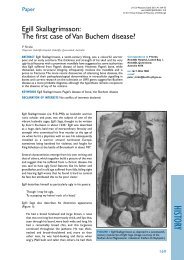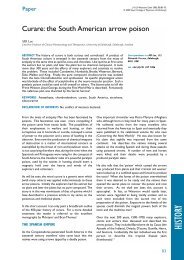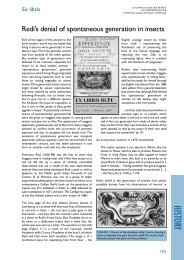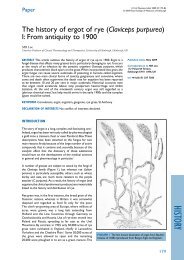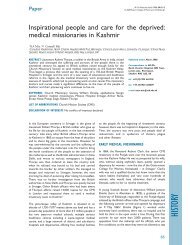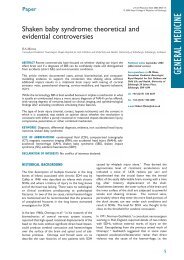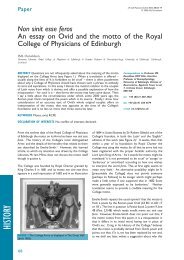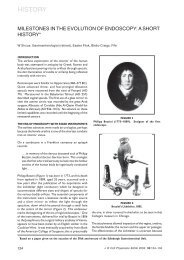The Solanaceae II: The mandrake (Mandragora officinarum); in ...
The Solanaceae II: The mandrake (Mandragora officinarum); in ...
The Solanaceae II: The mandrake (Mandragora officinarum); in ...
You also want an ePaper? Increase the reach of your titles
YUMPU automatically turns print PDFs into web optimized ePapers that Google loves.
HISTORY<br />
MR Lee<br />
THE MANDRAKE IN ENGLISH LITERATURE<br />
In the light of the long, ancient and bizarre history of the<br />
<strong>mandrake</strong>, it is no surprise that the plant should have been<br />
taken up by poets, dramatists and romantic novelists.<br />
<strong>The</strong>re is only space here to refer to a few strik<strong>in</strong>g<br />
examples. For a more extensive coverage the reader is<br />
referred to Thompson’s excellent treatise. 11<br />
By the time of Shakespeare, the root was imported<br />
widely and also cheaper alternatives, such as the<br />
white and black briony were available. <strong>The</strong> Bard of<br />
Avon makes a number of references to the root.<br />
Falstaff alludes twice to its effects on sexual<br />
performance <strong>in</strong> Henry IV Part <strong>II</strong> – first he addresses his<br />
page as ‘Thou whoresom <strong>mandrake</strong>’ and then<br />
condemns Justice Swallow as ‘the very genius of<br />
fam<strong>in</strong>e; yet lecherous as a monkey and the whores call<br />
him <strong>mandrake</strong>’ (Act I, Scene 2, and Act <strong>II</strong>I, Scene 2<br />
respectively). One of the most celebrated references<br />
to the plant is that <strong>in</strong> Othello (Act <strong>II</strong>I, Scene 8) where<br />
Iago referr<strong>in</strong>g to its narcotic qualities says ‘Not poppy<br />
nor mandragora; nor all the drowsy syrups of the<br />
world; shall ever medic<strong>in</strong>e thee to that sweet sleep<br />
which thou owdst yesterday.’<br />
<strong>The</strong> <strong>mandrake</strong>’s shriek<strong>in</strong>g on extraction is referred to <strong>in</strong><br />
Henry VI (Act <strong>II</strong>I, Scene 2) where Suffolk says:<br />
282<br />
‘Would curses kill as doth the <strong>mandrake</strong>’s groan<br />
I would <strong>in</strong>vent as bitter search<strong>in</strong>g terms<br />
As curst, as harsh and horrible to hear.’<br />
Other authors took up the mysterious herb <strong>in</strong>clud<strong>in</strong>g<br />
Marlowe and Drayton. In his popular play, <strong>The</strong> Jew of<br />
Malta, Marlowe causes Barabas to expla<strong>in</strong> how he escaped<br />
from prison by say<strong>in</strong>g:<br />
‘I drank poppy and cold <strong>mandrake</strong> juice;<br />
and be<strong>in</strong>g asleep belike they thought me dead<br />
And threw me over the walls.’<br />
This emphasises the prolonged sleep that <strong>mandrake</strong> can<br />
br<strong>in</strong>g on <strong>in</strong> which the <strong>in</strong>dividual can appear <strong>in</strong>sensible to<br />
pa<strong>in</strong> and almost ‘dead’.<br />
Michael Drayton, the Elizabethan poet was also well<br />
aware of the many properties of <strong>mandrake</strong> and <strong>in</strong> his<br />
work the Polyolbian refers to its association with the<br />
mistletoe, a plant sacred to the Druids. He may here have<br />
been confus<strong>in</strong>g it with the false <strong>mandrake</strong>s; the white or<br />
black briony. Plants grow<strong>in</strong>g under the mistletoe like<br />
‘<strong>mandrake</strong>’, such as cyclamen, purslane and valerian were<br />
all believed to <strong>in</strong>spire love.<br />
Dur<strong>in</strong>g the eighteenth and n<strong>in</strong>eteenth century, references<br />
to the <strong>mandrake</strong> decl<strong>in</strong>e steadily and by 1850 have all but<br />
disappeared. Perhaps the f<strong>in</strong>al quotation I should make is<br />
that from the Irish poet Thomas Moore (1779–1852) who<br />
<strong>in</strong> his epic poem Lalla Rookh says:<br />
‘Such rank and deadly lustre dwells<br />
As <strong>in</strong> these hellish fires that light<br />
<strong>The</strong> <strong>mandrake</strong>’s charnel leaves at night.’<br />
Also known as the Devil’s candle to the Arabs, why the<br />
<strong>mandrake</strong>’s leaves should glow at night has rema<strong>in</strong>ed a<br />
mystery. Once thought to be demonic possession a more<br />
prosaic explanation is that its scent attracted glowworms<br />
<strong>in</strong> the hot Eastern climes.<br />
THE SCEPTICAL HERBALISTS 1500 TO 1800<br />
As time went on <strong>in</strong>to the sixteenth and seventeenth<br />
centuries there came <strong>in</strong> turn the New Age of Herbalism;<br />
the era of rationalism and the Enlightenment. 12 Mandrake<br />
gather<strong>in</strong>g and its usage was submitted to question<strong>in</strong>g and<br />
analysis. Superstitions were jettisoned but therapeutic<br />
use ma<strong>in</strong>ta<strong>in</strong>ed.<br />
One of the most <strong>in</strong>terest<strong>in</strong>g early accounts <strong>in</strong> this<br />
period is that by William Turner, Dean of Wells<br />
Cathedral and Doctor of Physick, pr<strong>in</strong>ted <strong>in</strong> 1551. He<br />
describes the male and female forms of the roots but<br />
condemns the fact that manik<strong>in</strong>s (male) and puppettes<br />
(the female forms) are carved from the plants and sold<br />
to the credulous common people. ‘<strong>The</strong>y are thus<br />
deprived both of their wits and their money!’ He also<br />
condemns the legend relat<strong>in</strong>g to the gallows man as<br />
superstitious nonsense!<br />
However he does not abandon the <strong>mandrake</strong> completely,<br />
recommend<strong>in</strong>g it particularly as a soporific, pa<strong>in</strong>killer and<br />
to dull the agony of ‘burn<strong>in</strong>g’ and ‘cutt<strong>in</strong>g’. He also noted<br />
that taken <strong>in</strong>to the mouth it could cause numbness of the<br />
oral cavity and tongue (see Richardson later.)<br />
<strong>The</strong> next important account was that of John Gerarde (<strong>in</strong><br />
his famous Herbal of 1597) <strong>in</strong> which he also castigates the<br />
prevalent folk tales as be<strong>in</strong>g propagated by ‘old wives,<br />
runagate surgeons or physickmongers!’ He describes the<br />
tales of the gallows man and the rites practised <strong>in</strong> digg<strong>in</strong>g<br />
up the <strong>mandrake</strong> as ‘doltish errors.’ He also attacks the<br />
use of Brione (brionies <strong>in</strong> the modern parlance) as<br />
practised by ‘idle drones’ who carve out mannik<strong>in</strong>s from<br />
these plants and then pass these off to superstitious<br />
people as the true <strong>mandrake</strong>.<br />
<strong>The</strong> next <strong>in</strong>fluential authority to rail aga<strong>in</strong>st the <strong>mandrake</strong><br />
was John Park<strong>in</strong>son, by Royal Appo<strong>in</strong>tment Herbalist to<br />
the Court of Charles the First. He discusses the plant <strong>in</strong><br />
some detail <strong>in</strong> his book A Garden of Pleasant Flowers<br />
(1629). He blamed the chief magistrates of the City of<br />
London for tolerat<strong>in</strong>g the sale of <strong>mandrake</strong> mannik<strong>in</strong>s. He<br />
urged them to prosecute the vendors of such ‘toys which<br />
are the ridiculous products of man’s <strong>in</strong>vention.’<br />
J R Coll Physicians Ed<strong>in</strong>b 2006; 36:278–285<br />
© 2006 RCPE



